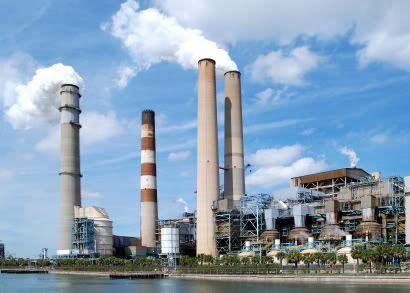“Transport Rule” (aka CAIR Replacement Rule) Proposed by U.S. EPA
U.S. EPA has released a pre-publication version of the proposed Transport Rule and is proposing to limit the interstate transport of emissions of nitrogen oxides (NOX) and sulfur dioxide (SO2). Under this proposal U.S. EPA would both identify and limit emissions within 32 states in the Eastern United States that affect the ability of downwind states to attain and maintain compliance with the 1997 and 2006 fine particulate matter (PM2.5) National Ambient Air Quality  Standards (NAAQS) and the 1997 ozone NAAQS. U.S. EPA is proposing to limit these emissions through Federal Implementation Plans (FIPs) that would regulate electric generating units (EGUs) in the 32 states. Emissions reductions will begin to take effect very quickly, in 2012, within one (1) year after the rule is finalized. This proposed rule would replace U.S. EPA’s 2005 Clean Air Interstate Rule (CAIR). This proposal is part of a series of rules that U.S. EPA plans to propose to further reduce NOX and SO2 emissions. Stay tuned for additional details in future editions of 4 The Record.
Standards (NAAQS) and the 1997 ozone NAAQS. U.S. EPA is proposing to limit these emissions through Federal Implementation Plans (FIPs) that would regulate electric generating units (EGUs) in the 32 states. Emissions reductions will begin to take effect very quickly, in 2012, within one (1) year after the rule is finalized. This proposed rule would replace U.S. EPA’s 2005 Clean Air Interstate Rule (CAIR). This proposal is part of a series of rules that U.S. EPA plans to propose to further reduce NOX and SO2 emissions. Stay tuned for additional details in future editions of 4 The Record.
Changes to the Greenhouse Gas Mandatory Reporting Rule
On June 28, 2010, the United States Environmental Protection Agency (U.S. EPA) issued a final rule that adds four (4) new source categories to those that will be required to submit annual greenhouse gas (GHG) emissions reports pursuant to the Greenhouse Gas Mandatory Reporting Rule codified at 40 CFR Part 98 (the GHG Reporting Rule). The source categories added to the GHG Reporting Rule by this final action are as follows:
- Magnesium production – Subpart T – Applies to any process in which magnesium metal is produced through smelting, refining, or remelting operations, or any process in which molten magnesium is used in alloying, casting, drawing, extruding, forming, or rolling operations.
- Underground coal mines – Subpart FF – Applies to active underground coal mines and any underground mines under development that have operational pre-mining degasification systems.
- Industrial wastewater treatment – Subpart II – Applies to anaerobic processes used to treat industrial wastewater and industrial wastewater treatment sludge at facilities that perform pulp and paper manufacturing, food processing, ethanol production, and petroleum refining.
- Industrial waste landfills – Subpart TT – Originally proposed as a part of Subpart HH for municipal solid waste landfills, this new subpart applies to industrial waste landfills that accepted waste on or after January 1, 1980 and that are located at a facility whose total landfill design capacity is greater than or equal to 300,000 metric tons. This source category does not include municipal solid waste landfills, RCRA Subtitle C or TSCA hazardous waste landfills, dedicated construction and demolition waste landfills, or industrial waste landfills that only receive one (1) or more of certain inert waste materials.
These four (4) new final subparts will become effective 60 days after being published in the Federal Register. Facilities that include these source categories will be required to report their emissions to U.S. EPA if they emit 25,000 metric tons carbon dioxide equivalent (CO2e) or more per year in combined emissions from all source categories covered by 40 CFR Part 98. Monitoring of GHG emissions from these four (4) new source categories must begin January 1, 2011 and the first annual report including emissions from these new source categories will have to be submitted to U.S. EPA by March 31, 2012.
In issuing these new source categories, U.S. EPA also announced a final decision not to include ethanol production and food processing as distinct subparts in 40 CFR Part 98, as well as the final decision not to include suppliers of coal in 40 CFR Part 98 at this time. These types of facilities are still required to report emissions under other subparts of the rule if they meet the reporting threshold of 25,000 metric tons of CO2e per year for all covered emissions sources.
These new source categories being finalized were proposed but not finalized when 40 CFR Part 98 was published in the October 30, 2009 Federal Register. The monitoring requirements for magnesium production, underground coal mines, industrial wastewater treatment, and industrial waste landfills have not changed significantly from when they were proposed in 2009. However, U.S. EPA has added a provision that will allow facilities in these source categories to submit a request to use Best Available Monitoring Methods (BAMM) instead of using the monitoring methods specified in each subpart for calendar year 2011 monitoring. The use of BAMM will not be approved beyond December 31, 2011.
Facilities which include any of these new source categories which are not currently subject to the GHG Reporting Rule for emissions in 2010 must determine if they will now become subject to reporting requirements beginning in 2011 and, if so, prepare a GHG Monitoring Plan prior to when the new monitoring requirements take effect. Likewise, facilities currently subject to the GHG Reporting Rule which include any of these new source categories should become familiar with the new monitoring requirements and make revisions to existing GHG Monitoring Plans accordingly. A pre-publication copy of U.S. EPA’s final action to add the new source categories to the GHG Reporting Rule can be found here.
Changes to the Greenhouse Gas Mandatory Reporting Rule
On June 28, 2010, the United States Environmental Protection Agency (U.S. EPA) issued a final rule that adds four (4) new source categories to those that will be required to submit annual greenhouse gas (GHG) emissions reports pursuant to the Greenhouse Gas Mandatory Reporting Rule codified at 40 CFR Part 98 (the GHG Reporting Rule). The source categories added to the GHG Reporting Rule by this final action are as follows:
Magnesium production – Subpart T
Applies to any process in which magnesium metal is produced through smelting, refining, or remelting operations, or any process in which molten magnesium is used in alloying, casting, drawing, extruding, forming, or rolling operations.
Underground coal mines – Subpart FF
Applies to active underground coal mines and any underground mines under development that have operational pre-mining degasification systems.
Industrial wastewater treatment – Subpart II
Applies to anaerobic processes used to treat industrial wastewater and industrial wastewater treatment sludge at facilities that perform pulp and paper manufacturing, food processing, ethanol production, and petroleum refining.
Industrial waste landfills – Subpart TT
Originally proposed as a part of Subpart HH for municipal solid waste landfills, this new subpart applies to industrial waste landfills that accepted waste on or after January 1, 1980 and that are located at a facility whose total landfill design capacity is greater than or equal to 300,000 metric tons. This source category does not include municipal solid waste landfills, RCRA Subtitle C or TSCA hazardous waste landfills, dedicated construction and demolition waste landfills, or industrial waste landfills that only receive one (1) or more of certain inert waste materials.
These four (4) new final subparts will become effective 60 days after being published in the Federal Register. Facilities that include these source categories will be required to report their emissions to U.S. EPA if they emit 25,000 metric tons carbon dioxide equivalent (CO2e) or more per year in combined emissions from all source categories covered by 40 CFR Part 98. Monitoring of GHG emissions from these four (4) new source categories must begin January 1, 2011 and the first annual report including emissions from these new source categories will have to be submitted to U.S. EPA by March 31, 2012.

These new source categories being finalized were proposed but not finalized when 40 CFR Part 98 was published in the October 30, 2009 Federal Register. The monitoring requirements for magnesium production, underground coal mines, industrial wastewater treatment, and industrial waste landfills have not changed significantly from when they were proposed in 2009. However, U.S. EPA has added a provision that will allow facilities in these source categories to submit a request to use Best Available Monitoring Methods (BAMM) instead of using the monitoring methods specified in each subpart for calendar year 2011 monitoring. The use of BAMM will not be approved beyond December 31, 2011.
Facilities which include any of these new source categories which are not currently subject to the GHG Reporting Rule for emissions in 2010 must determine if they will now become subject to reporting requirements beginning in 2011 and, if so, prepare a GHG Monitoring Plan prior to when the new monitoring requirements take effect. Likewise, facilities currently subject to the GHG Reporting Rule which include any of these new source categories should become familiar with the new monitoring requirements and make revisions to existing GHG Monitoring Plans accordingly. A pre-publication copy of U.S. EPA’s final action to add the new source categories to the GHG Reporting Rule can be found here.
Boiler MACT and CISWI: To Comment or Not to Comment?… that is the question.
To associate Shakespeare and the Boiler MACT/CISWI regulations is quite a stretch I know, but I believe that the decision “to comment or not to comment” is as metaphorically significant as Hamlet’s “to be or not to be” and certainly answers the question of what to do next. In ALL4’s recent Boiler MACT Webinar Series, we touched on the importance of commenting during each of our sessions. The ability to influence applicability determinations, emission standards, monitoring techniques, and compliance timelines all present themselves in the commenting process. Equally important, the act of submitting comments preserves the ability to challenge the regulations in the future. In most comment submittals, the comments contain a combination of legal and technical issues. Our discussions with members of the legal and the regulated manufacturing communities indicate that many believe that the legal merits of the proposed Boiler MACT and CISWI rules have already been addressed and challenged in the Hospital/Medical/Infectious Waste Incinerator (HMIWI) rules (60 CFR Part 60, Subparts Ce and Ec). Most legal and industry insiders believe that any decisions made on that HMIWI case will have an obvious “trickle down” effect on the other regulations. As such, many potential commenters are focusing on the technical issues in the comment process.
ALL4 was part of the team that developed HMIWI rule comments on behalf of the Medical Waste Institute (MWI) and the Integrated Waste Services Association (IWSA) – now known as the Energy Recovery Council (ERC). The comments included over 90 pages of legal and technical arguments. While the legal arguments are still playing out, there was considerable progress on the technical comments. From a 50,000 foot level, ALL4 highlights the following lessons learned:
- The comments made a difference – emission
limits were changed between the proposed rule and the final rule. All of the changes resulted in less stringent emission limits in the final rule.
- It takes a lot of time and money to develop meaningful comments – the effort involved to develop substantive comments in significant. The work involves the joint effort of environmental, operations, legal, and statistician personnel.
- U.S. EPA wanted to get the right data and develop the emission standards based on an approach currently in place – while there are still legal arguments around how the top 12% performing units should be selected (i.e., pollutant-by-pollutant vs. unit-by-unit overall performance), U.S. EPA was open to receiving additional data and applied statistical analyses to the data to develop the emission limits.
- U.S. EPA appears to be tied to the rulemaking schedule dictated to them – comments were considered in context with how they could be incorporated while still ensuring that the rule would be finalized consistent with the schedules laid out by the Court.
Several of the issues around the HMIWI rule are very similar to the types of issues that are associated with the Boiler MACT and CISWI rules:
- Concerns about the quality, accuracy, and completeness of the test data that was relied upon to develop the proposed emission limits.
- Concerns about the operating conditions under which the emission test data (and resulting emission limits) were developed (i.e., steady state, optimum conditions vs. startup/shutdown/malfunction, variable operating conditions).
- Rule development input from both the legal and technical arms of U.S. EPA.
In the case of the HMIWI rules, comments led to emission limit revisions that benefited industry based on comments from interested parties. That result alone is pretty compelling when facing the question of “To comment or not to comment.”

 limits were changed between the proposed rule and the final rule. All of the changes resulted in less stringent emission limits in the final rule.
limits were changed between the proposed rule and the final rule. All of the changes resulted in less stringent emission limits in the final rule. 